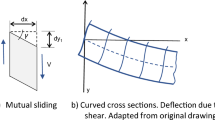Abstract
A method is presented for calculation of the design state of stress in the working range in an arbitrary cross section of a cracked reinforced concrete beam, using the value of the modular ration as the only unknown coefficient. The method is applied to shrinkage in reinforced concrete.
Résumé
On décrit une méthode par laquelle les charges admissibles engendrées dans les conditions de service, ainsi que leur distribution dans un élément de poutre en béton armé délimité par deux fissures adjacentes, peuvent être calculées au moyen d'une simple inconnue, la valeur du coefficient d'équivalence “n”. On tient compte du fluage et des déplacements relatifs entre les matériaux.
On a vérifié la méthode pour les charges dues au retrait, la valeur correspondante de n étant d'abord déterminée à partir de certains résultats de mesure puis substituées dans les formules à la contrainte limite supérieure de l'armature et au fléchissement maximal. On a comparé les résultats avec les observations faites au cours d'essais sur 5 poutres à pourcentages d'armature différents.
Similar content being viewed by others
Abbreviations
- A sj :
-
total cross sectional area of thejth layer of the reinforcement
- B cr :
-
mean value of the bond stressτ mj immediately prior to failure,T c, in tension
- E s :
-
modulus of elasticity of the reinforcement
- K j :
-
argument of hyperbolic functions included in a formula describing the bond stress distribution along the surface area of thejth layer of reinforcement
- L :
-
length of an uncracked beam or length of an uncracked element of the same beam (crack spacing)
- R :
-
radius of curvature of the beam
- S(Smj):
-
difference at an arbitrary cross section between the strains, due only to the external action, in the reinforcement and the concrete respectively (corresponding mean value along the length of the element at the level of centroid of thejth layer of reinforcement)
- T c :
-
ultimate tensile strength of the concrete (not to be mistaken for the statistical mean value)
- n :
-
ratio, adapted to an actual load combination and a definite instant of time, between the modulus of elasticity of the reinforcement and the modulus of deformation of the concrete (the secant modulus in a stress-strain diagram)
- n *j :
-
a strain compensated value ofn (\(n*j = n \cdot \bar \mu _{ej} /\mu _{ej} \))
- p j :
-
sum of the perimeters of the reinforcing bars in thejth layer
- w j :
-
mean value of the crack width at the level of the centroid of thejth layer of reinforcement
- α in :
-
ratio between the values of the normal stress in the concrete at the top and bottom edges of the cross section. (If both values have been given the same signα in is equal to—c u/cl, and if they have been given the opposite signα in is equal to +c u/cl).
- δ j :
-
mean value of the relative displacement between the concrete and the reinforcement at the centroid of thejth layer of reinforcement
- ε cj andε sj :
-
strain in the concrete and the reinforcement respectively at the level of the centroid of thejth layer of reinforcement
- μ j :
-
geometrical reinforcement percentage, i.e. the ratioA sj/bh between the total cross sectional area of thejth layer of reinforcement and a concrete area equal to the product of the width and height of the beam
- μ ej :
-
effective reinforcement percentage
- \(\bar \mu _{ej} \) :
-
effective reinforcement percentage relating to an assumed linear distribution of the normal stress in the concrete
- ξ j :
-
ratio of the distance between the bottom edge of the beam and the centroid of thejth layer of reinforcement to the overall height of the beam
- σ cj andσ sj :
-
mean value of the normal stress in the concrete and thejth layer of reinforcement respectively at the centroid of the same layer
- τ j :
-
bond stress along the surface area of thejth layer of reinforcement
References
Coignet, E., etTédesco, N.—Du calcul des ouvrages en ciment avec ossature métallique. Mémoires de la société des ingénieurs civils de France, 1894, I, pp. 282–363.
Osterman, J.—Utdragsprovet, Betong, Vol. 36, 1, Stockholm 1951, pp. 1–8 (in Swedish).
Ödman, S.T.A.—Shrinkage in Reinforced Concrete Beams, Nordisk Betong, 16. H.4, Stockholm 1972.
Ödman, S.T.A.—Analysis of Stresses in a Cracked Reinforced Concrete Beam. To be published.
Ödman, S.T.A.—Tests on Shrinkage in Reinforced Concrete Beams. To be published.
Author information
Authors and Affiliations
Rights and permissions
About this article
Cite this article
Ödman, S.T.A. The strain compensated modular ratio method and its application. Mat. Constr. 6, 123–128 (1973). https://doi.org/10.1007/BF02475144
Issue Date:
DOI: https://doi.org/10.1007/BF02475144




